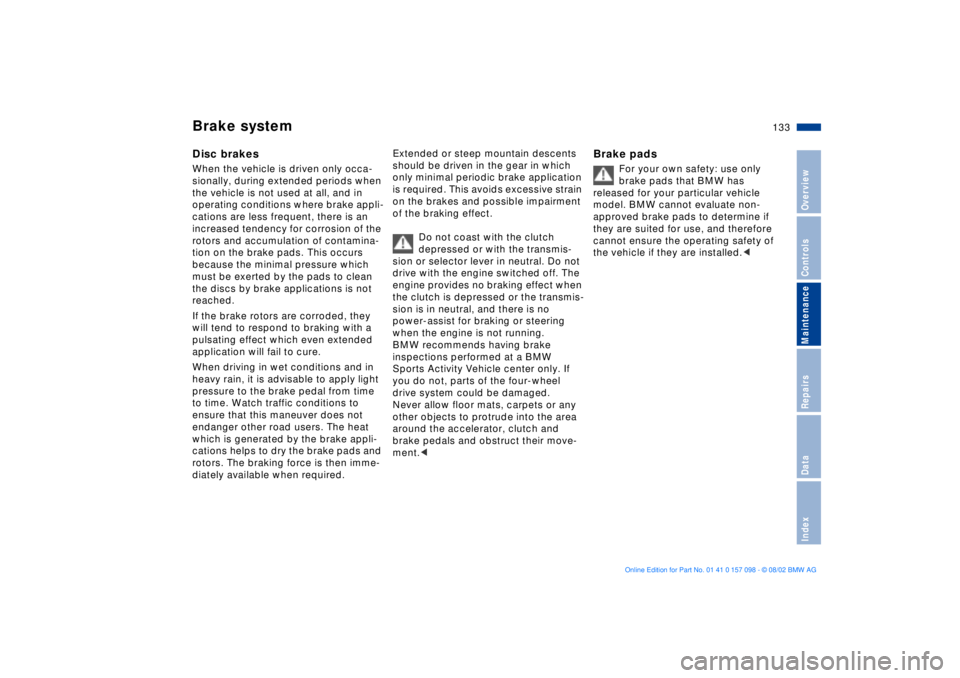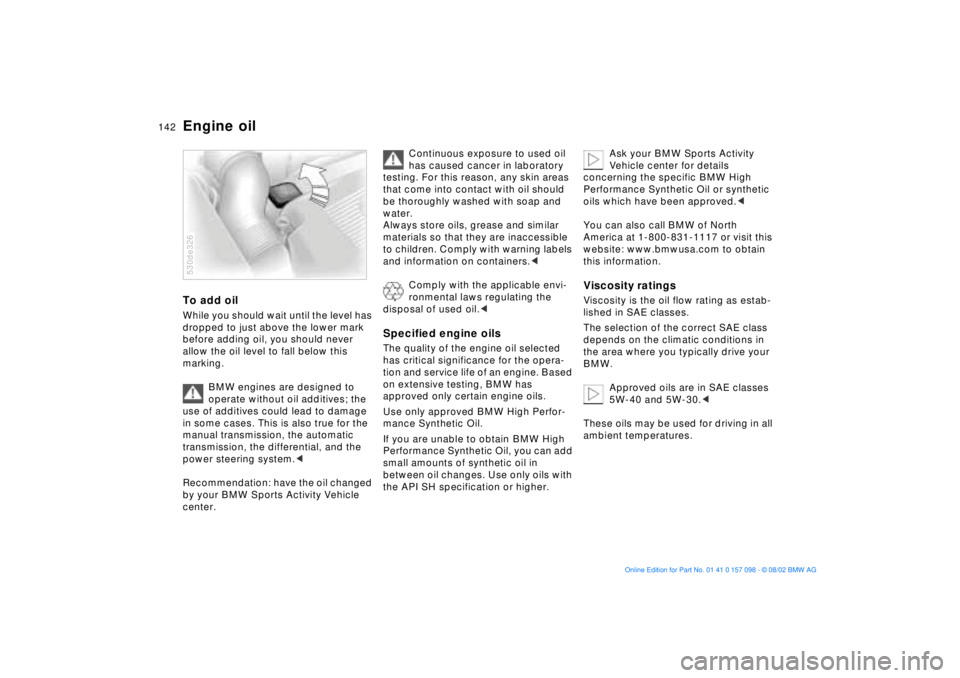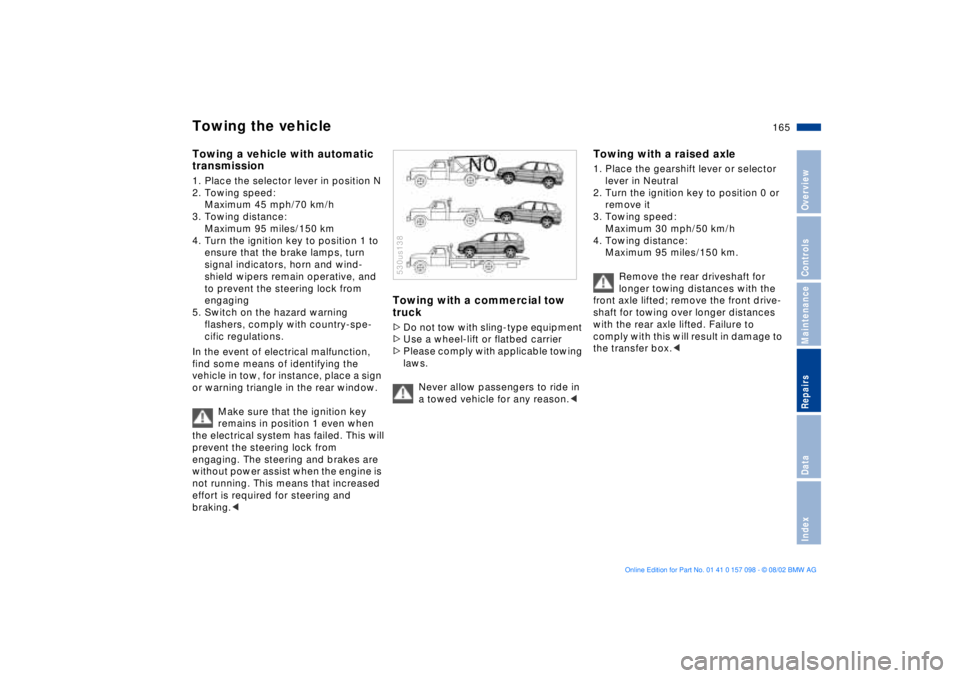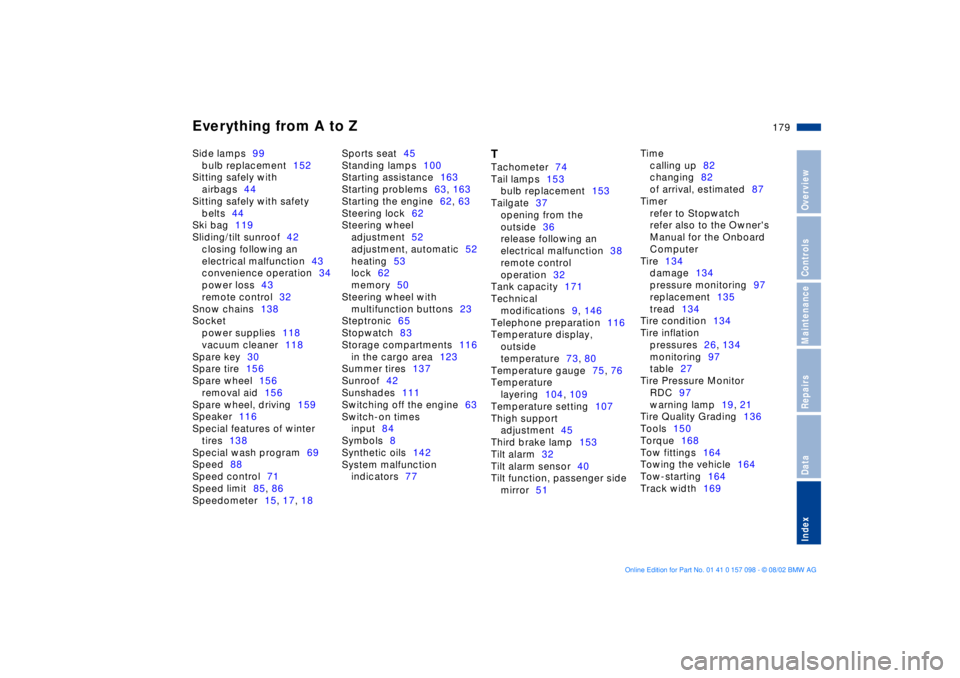2003 BMW X5 3.0I power steering
[x] Cancel search: power steeringPage 4 of 183

Contents
© 2002 Bayerische Motoren Werke
Aktiengesellschaft
Munich, Germany
Reprinting, including excerpts, only with the
written consent of BMW AG, Munich.
Order No. 01 41 0 157 098
US English IX/2002
Printed in Germany
Printed on environmentally friendly paper Ð
bleached without chlorine, suitable for recycling.
Notes
Overview
Controls and features
About this Owner's Manual 8
Symbols used 8
The individual vehicle 8
Status at time of printing 9
For your own safety 9
Symbol on vehicle parts 10
Service and Warranty 10
Reporting safety defects 10Cockpit
14
Instrument cluster 15
Indicator and warning lamps 19
Steering wheel with multifunction buttons 23
Warning triangle 24
First-aid kit 24
Refueling 24
Fuel specifications 26
Tire inflation pressures 26
Locks and security systems:
Keys30
Central locking system 30
Opening and closing Ð via the remote control 31
Opening and closing Ð via the door lock 34
Opening and closing Ð from the inside 35
Liftgate 36
Tailgate 37
Alarm system 39
Electric power windows 40
Sliding/tilt sunroof with glass moonroof 42
Adjustments:
Safe seating position 44
Seats 44
Mechanical seat 45
Power seat 46
Head restraints 47
Power rear-seat backrest adjustment 48
Safety belts 49
Seat, mirror and steering wheel
memory 50
Seat heating 51
Steering wheel 52
Steering wheel heating 53
Mirrors 53
Inhalt
Page 44 of 183

44n
The condition for relaxed, fatigue-free
driving is a seating position adjusted to
your needs. Together with the safety
belts and the airbags, the seating posi-
tion is very important for the passive
safety of the occupants in the case of
an accident. Therefore, observe the
following instructions, as otherwise the
protective function of the safety
systems may be impaired.
For additional information on trans-
porting children safely, refer to
page 58.
Sitting safely with airbags
Maintain a distance to the airbags.
Always hold the steering wheel by
the rim with the hands at the 9 and
3-o'clock positions to keep any chance
of injury to hands or arms to an abso-
lute minimum, should the airbag be
deployed. No one and nothing is to
come between the airbags and the seat
occupant. Do not use the cover of the
front airbag on the front passenger side
as a storage area for objects, or as a
rest for feet or legs.<
For the location of the airbags and
additional information, refer to page 55.
Sitting safely with safety belts
Never allow more than one person
to wear a single safety belt. Never
allow infants or small children to ride in
a passenger's lap. Avoid twisting the
belt while routing it firmly across the
pelvis and shoulder, wear it as snugly
against your body as possible. Do not
allow the belt to rest against hard or
fragile objects in your pockets. Never
route the belt across your neck, do not
run it across sharp edges and ensure
that the belt does not become caught
or jammed. Avoid wearing bulky
clothing and pull on the lap belt periodi-
cally to retension it over your shoulders.
In the event of a frontal impact, a loose
lap belt could slide over your hips,
leading to abdominal injury. In addition,
the safety belt's restraint effectiveness
is reduced if the belt is worn loosely.
Expectant mothers should always wear
their safety belts, taking care to position
the lap belt against the lower hips,
where it will not exert pressure against
the abdominal area.<
For instructions on operating the safety
belts, refer to page 49.
Observe the following before
adjusting
Never try to adjust your seat while
operating the vehicle. The seat
could respond with unexpected move-
ment, and the ensuing loss of vehicle
control could lead to an accident. Never
ride with the backrest reclined to an
extreme horizontal angle Ð especially
important for front passengers to
remember.
If you do so there is a risk that you will
slide under the safety belt in an acci-
dent, thus reducing the protection
provided by the safety belt
.<
Seat adjustment>Mechanical seat adjustment, refer to
page 45
>Power seat adjustment, refer to
page 46
>Head restraints, refer to page 47
>Power rear-seat backrest adjustment,
refer to page 48
Safe seating position Seats
Page 133 of 183

133n
OverviewControlsMaintenanceRepairsDataIndex
Brake systemDisc brakesWhen the vehicle is driven only occa-
sionally, during extended periods when
the vehicle is not used at all, and in
operating conditions where brake appli-
cations are less frequent, there is an
increased tendency for corrosion of the
rotors and accumulation of contamina-
tion on the brake pads. This occurs
because the minimal pressure which
must be exerted by the pads to clean
the discs by brake applications is not
reached.
If the brake rotors are corroded, they
will tend to respond to braking with a
pulsating effect which even extended
application will fail to cure.
When driving in wet conditions and in
heavy rain, it is advisable to apply light
pressure to the brake pedal from time
to time. Watch traffic conditions to
ensure that this maneuver does not
endanger other road users. The heat
which is generated by the brake appli-
cations helps to dry the brake pads and
rotors. The braking force is then imme-
diately available when required.Extended or steep mountain descents
should be driven in the gear in which
only minimal periodic brake application
is required. This avoids excessive strain
on the brakes and possible impairment
of the braking effect.
Do not coast with the clutch
depressed or with the transmis-
sion or selector lever in neutral. Do not
drive with the engine switched off. The
engine provides no braking effect when
the clutch is depressed or the transmis-
sion is in neutral, and there is no
power-assist for braking or steering
when the engine is not running.
BMW recommends having brake
inspections performed at a BMW
Sports Activity Vehicle center only. If
you do not, parts of the four-wheel
drive system could be damaged.
Never allow floor mats, carpets or any
other objects to protrude into the area
around the accelerator, clutch and
brake pedals and obstruct their move-
ment.<
Brake pads
For your own safety: use only
brake pads that BMW has
released for your particular vehicle
model. BMW cannot evaluate non-
approved brake pads to determine if
they are suited for use, and therefore
cannot ensure the operating safety of
the vehicle if they are installed.<
Page 142 of 183

142n
Engine oil To add oilWhile you should wait until the level has
dropped to just above the lower mark
before adding oil, you should never
allow the oil level to fall below this
marking.
BMW engines are designed to
operate without oil additives; the
use of additives could lead to damage
in some cases. This is also true for the
manual transmission, the automatic
transmission, the differential, and the
power steering system.<
Recommendation: have the oil changed
by your BMW Sports Activity Vehicle
center. 530de326
Continuous exposure to used oil
has caused cancer in laboratory
testing. For this reason, any skin areas
that come into contact with oil should
be thoroughly washed with soap and
water.
Always store oils, grease and similar
materials so that they are inaccessible
to children. Comply with warning labels
and information on containers.<
Comply with the applicable envi-
ronmental laws regulating the
disposal of used oil.<
Specified engine oils The quality of the engine oil selected
has critical significance for the opera-
tion and service life of an engine. Based
on extensive testing, BMW has
approved only certain engine oils.
Use only approved BMW High Perfor-
mance Synthetic Oil.
If you are unable to obtain BMW High
Performance Synthetic Oil, you can add
small amounts of synthetic oil in
between oil changes. Use only oils with
the API SH specification or higher.
Ask your BMW Sports Activity
Vehicle center for details
concerning the specific BMW High
Performance Synthetic Oil or synthetic
oils which have been approved.<
You can also call BMW of North
America at 1-800-831-1117 or visit this
website: www.bmwusa.com to obtain
this information.
Viscosity ratings Viscosity is the oil flow rating as estab-
lished in SAE classes.
The selection of the correct SAE class
depends on the climatic conditions in
the area where you typically drive your
BMW.
Approved oils are in SAE classes
5W-40 and 5W-30.<
These oils may be used for driving in all
ambient temperatures.
Page 165 of 183

165n
OverviewControlsMaintenanceRepairsDataIndex
Towing the vehicle Towing a vehicle with automatic
transmission1. Place the selector lever in position N
2. Towing speed:
Maximum 45 mph/70 km/h
3. Towing distance:
Maximum 95 miles/150 km
4. Turn the ignition key to position 1 to
ensure that the brake lamps, turn
signal indicators, horn and wind-
shield wipers remain operative, and
to prevent the steering lock from
engaging
5. Switch on the hazard warning
flashers, comply with country-spe-
cific regulations.
In the event of electrical malfunction,
find some means of identifying the
vehicle in tow, for instance, place a sign
or warning triangle in the rear window.
Make sure that the ignition key
remains in position 1 even when
the electrical system has failed. This will
prevent the steering lock from
engaging. The steering and brakes are
without power assist when the engine is
not running. This means that increased
effort is required for steering and
braking.<
Towing with a commercial tow
truck >Do not tow with sling-type equipment
>Use a wheel-lift or flatbed carrier
>Please comply with applicable towing
laws.
Never allow passengers to ride in
a towed vehicle for any reason.< 530us138
Towing with a raised axle 1. Place the gearshift lever or selector
lever in Neutral
2. Turn the ignition key to position 0 or
remove it
3. Towing speed:
Maximum 30 mph/50 km/h
4. Towing distance:
Maximum 95 miles/150 km.
Remove the rear driveshaft for
longer towing distances with the
front axle lifted; remove the front drive-
shaft for towing over longer distances
with the rear axle lifted. Failure to
comply with this will result in damage to
the transfer box.<
Page 178 of 183

Everything from A to ZPPark Distance Control
PDC90
Parking aid90
Parking brake20, 64
Parking lamps99
Particle filter104, 110
Passenger side mirror tilt
function51
PDC Park Distance
Control90
Please fasten safety belts
warning lamp20
Poor driving conditions131
Power loss
sliding/tilt sunroof43
Power outlets
flashlight124
other appliances124
vacuum cleaner124
Power rating168
Power rear-seat
backrests48
Power seat46
Power windows40
safety switch41
Pull-out cargo floor124
RRain sensor68
RDC Tire Pressure
Monitor97
warning lamp19, 21
Rear backrests, folding
down120
Rear lamps153
Rear passenger area climate
control109
Rear seats, power48
Rear window
defroster103, 108
Rear window wiper70
blade replacement150
Rear-seat backrest, folding
down120
Rear-seat backrests,
power48
Rearview mirrors
exterior53
interior54
Rechargeable flashlight115
Recirculated-air
mode103, 108
Reclining seat44
Refueling24, 181
Releasing
hood139
tailgate following an
electrical malfunction38Reminder signal Ð Memo83
Remote control31
computer89
Removal aid for the spare
wheel156
Removing condensation
from the
windows104, 107
Replacing
antifreeze, radiator143
bulbs151
fuses160
windshield wiper
blades150
Reporting safety defects10
Reservoir, washer
system141
Residual heat106, 109
Reverse65
Rims137
Roller sun blinds111
Roof load capacity170
Roof-mounted luggage
rack127
SSafe seating position44
with airbags44
with safety belts44
Safety belts49
height adjustment49Safety defects, reporting10
Safety lock buttons35
Seat adjustment44
Seat belts49
Seat, electric power46
Seat heating51
Seat, mechanical45
Seat memory50
Seat, mirror and steering
wheel memory50
Securing cargo38, 126
Selector lever, automatic
transmission66
Self-leveling
suspension94, 131
inactive94
warning lamp21
Service and Warranty
Information Booklet for US
models145
Service Engine Soon
indicator lamp21
Service Interval
Display76, 145
Set temperature107
Shiftlock66
Shoulder support47
Side airbags55
Side Impact Head Protection
System55
Page 179 of 183

Everything from A to Z
179n
OverviewControlsMaintenanceRepairsDataIndex
Side lamps99
bulb replacement152
Sitting safely with
airbags44
Sitting safely with safety
belts44
Ski bag119
Sliding/tilt sunroof42
closing following an
electrical malfunction43
convenience operation34
power loss43
remote control32
Snow chains138
Socket
power supplies118
vacuum cleaner118
Spare key30
Spare tire156
Spare wheel156
removal aid156
Spare wheel, driving159
Speaker116
Special features of winter
tires138
Special wash program69
Speed88
Speed control71
Speed limit85, 86
Speedometer15, 17, 18Sports seat45
Standing lamps100
Starting assistance163
Starting problems63, 163
Starting the engine62, 63
Steering lock62
Steering wheel
adjustment52
adjustment, automatic52
heating53
lock62
memory50
Steering wheel with
multifunction buttons23
Steptronic65
Stopwatch83
Storage compartments116
in the cargo area123
Summer tires137
Sunroof42
Sunshades111
Switching off the engine63
Switch-on times
input84
Symbols8
Synthetic oils142
System malfunction
indicators77
TTachometer74
Tail lamps153
bulb replacement153
Tailgate37
opening from the
outside36
release following an
electrical malfunction38
remote control
operation32
Tank capacity171
Technical
modifications9, 146
Telephone preparation116
Temperature display,
outside
temperature73, 80
Temperature gauge75, 76
Temperature
layering104, 109
Temperature setting107
Thigh support
adjustment45
Third brake lamp153
Tilt alarm32
Tilt alarm sensor40
Tilt function, passenger side
mirror51Time
calling up82
changing82
of arrival, estimated87
Timer
refer to Stopwatch
refer also to the Owner's
Manual for the Onboard
Computer
Tire134
damage134
pressure monitoring97
replacement135
tread134
Tire condition134
Tire inflation
pressures26, 134
monitoring97
table27
Tire Pressure Monitor
RDC97
warning lamp19, 21
Tire Quality Grading136
Tools150
Torque168
Tow fittings164
Towing the vehicle164
Tow-starting164
Track width169